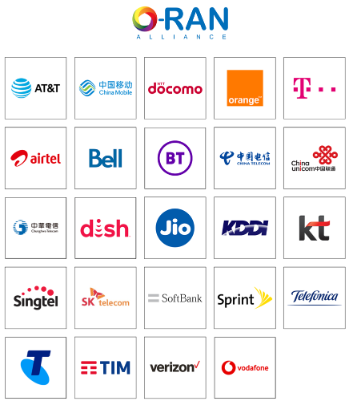
5G Testing: What Is O-RAN? – Part 1
Open radio access network (O-RAN) is an operator-led alliance formed in February 2018 by five global operators to define the next-generation radio access network (RAN) architecture. The O-RAN Alliance defines the specifications, the reference architecture, and the interfaces between the various subcomponents that form the O-RAN.
O-RAN is a merger between the XRAN group and the C-RAN Alliance whose purpose was to define virtualized RANs. Membership has grown from 5 to 24 global operators since its formation. It also includes 148 other contributors including network equipment manufacturers (NEMs), chipset manufacturers, and companies that build stacks and radio elements.

Figure 1. O-RAN Alliance operator members

The desire for wireless operators to move their networks from physical purpose-built hardware to virtual and cloud-based software implementations emerged with 4G. While it is closer to reality for the core network, the O-RAN group is working to achieve this goal for the RAN. The group is specifying the discrete components of the RAN and standardized interfaces between them to allow hosting on white-box hardware instead purpose-built hardware and open the door for operators to a plethora of vendors that excel in their area of focus. Each subcomponent of the O-RAN can come from a different vendor, even pieces within subcomponents.
O-RAN versus Other Groups
O-RAN should not be confused with OpenRAN though. O-RAN is the group that specifies and defines the RAN infrastructure. In some cases, it works with the 3rd Generation Partnership Project (3GPP) to refine the specifications further, like the X2 interface, which is the interface between the eNodeB and gNodeB. OpenRAN is a project group in the Telecom Infrastructure Project (TIP) that focuses on interoperability between the various disaggregated RAN components using open interfaces. O-RAN and OpenRAN will work together in the future. A contract allows OpenRAN to reuse some of the specifications defined by the O-RAN Alliance to advance interoperability testing.
The Open Networking Foundation is yet another group. Its purpose is to build open-source software. The group works closely with the O-RAN Alliance on open-source implementations that can be verified using O-RAN components and conform to the specifications defined by the O-RAN Alliance.
Recently, a new group has emerged - the Open RAN Policy Coalition. The purpose of this group is to advocate government policy to drive open RAN adoption.
O-RAN Core Principles
The O-RAN Alliance adopts two core principles - openness and intelligence. Service agility and cloud-scale economics require the virtualization of services into network functions and using large cloud-scale operators that provide larger components at a lower cost. Service agility requires moving services into production quickly. This process is faster using software than hardware. Hardware takes time because the equipment needs to be tested thoroughly in the laboratory with various other components before going into the field.
With O-RAN, operators can work directly with RF contract manufacturers, companies that specialize in graphics processing units (GPUs) and field programmable gate arrays (FPGAs), and virtual cloud infrastructure providers. They can mix and match components and work with specialists to create powerful and unique solutions. O-RAN increases competition in the ecosystem to the operators’ advantage while embracing open-source software.
The second principle, intelligence, stems from the fact that 5G will generate a significant amount of data, making it humanly impossible to analyze it and take corrective actions on the network, whether it be to add capacity or deploy certain services in specific regions, in a timely manner. The use of artificial intelligence (AI) and machine learning models will grow to collect data, perform analysis, and feed the information back to the network in an automated fashion. Self-driving networks will drive a significant reduction in operational expenses. Studies show a 40% to 50% reduction in OPEX costs for network service providers.
O-RAN enables the transformation and virtualization of the RAN in 5G infrastructure. It brings significant opportunities to network operators. It also brings several new challenges. To learn more about the O-RAN architecture and upcoming challenges, read my next blog, 5G Testing: What Is O-RAN? – Part 2.
You can also learn more about 5G technologies, challenges, and solutions at www.keysight.com/find/5G.